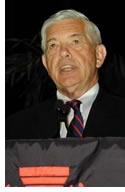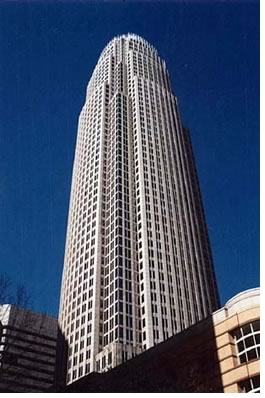
 Friday's
keynote speaker—Hugh L. McColl Jr., former chair and CEO of Bank
of America Corporation, one of the largest, fastest growing financial
institutions in the country—presented another side of what makes
the successful architecture: the informed and responsive client. Jay McGraw,
group publisher, McGraw-Hill Construction, which sponsored all of the
convention plenary sessions, introduced McColl, whom he characterized
as "guiding the Bank of America for 18 years," including its
$350 billion investment into building up and restoring downtown Charlotte—from
housing to the arts.
Friday's
keynote speaker—Hugh L. McColl Jr., former chair and CEO of Bank
of America Corporation, one of the largest, fastest growing financial
institutions in the country—presented another side of what makes
the successful architecture: the informed and responsive client. Jay McGraw,
group publisher, McGraw-Hill Construction, which sponsored all of the
convention plenary sessions, introduced McColl, whom he characterized
as "guiding the Bank of America for 18 years," including its
$350 billion investment into building up and restoring downtown Charlotte—from
housing to the arts.
 "I
love architecture," McColl exclaimed. "When done well, architecture
enriches the lives of all its citizens." Charlotte has great architecture,
he said, due in no small part to the proximity of the University of North
Carolina School of Architecture at Charlotte, whose professors have continually
prodded the city leaders into looking at the city in a different way and
as part of a larger context. McColl also credited Charlotte architects
A.G. "Gouldie" Odell and Harvey Gantt, FAIA, with teaching him
another important tenet of good architecture: the importance of context
and working with a master plan for the city that drives future development.
"I
love architecture," McColl exclaimed. "When done well, architecture
enriches the lives of all its citizens." Charlotte has great architecture,
he said, due in no small part to the proximity of the University of North
Carolina School of Architecture at Charlotte, whose professors have continually
prodded the city leaders into looking at the city in a different way and
as part of a larger context. McColl also credited Charlotte architects
A.G. "Gouldie" Odell and Harvey Gantt, FAIA, with teaching him
another important tenet of good architecture: the importance of context
and working with a master plan for the city that drives future development.
 McColl
is rightly proud of Charlotte in 2002, singling out the city's current
residential building boom and the trolley line that is tying the city
together. Charlotte in the 1970s, though, was small and unremarkable,
he said, and it was the Bank of America's 40-story corporate headquarters
building that led the renaissance of the center city. McColl likened the
building's architect, Cesar Pelli, FAIA, to Tom Builder, Ken Follett's
fictional Pillars of the Earth medieval master builder, who "tempered
the harshness of the structure with the softness of nature." McColl
marveled at how Pelli began the process of designing a building, which
was by "walking the streets of the city and listening to the client.
He helped us understand our hopes and dreams." The building defines
Charlotte's skyline, yet is respectful of its surround. Everyone got what
they wanted in the end, McColl joked. "It's a warm and friendly building
that reeks of power and wealth."
McColl
is rightly proud of Charlotte in 2002, singling out the city's current
residential building boom and the trolley line that is tying the city
together. Charlotte in the 1970s, though, was small and unremarkable,
he said, and it was the Bank of America's 40-story corporate headquarters
building that led the renaissance of the center city. McColl likened the
building's architect, Cesar Pelli, FAIA, to Tom Builder, Ken Follett's
fictional Pillars of the Earth medieval master builder, who "tempered
the harshness of the structure with the softness of nature." McColl
marveled at how Pelli began the process of designing a building, which
was by "walking the streets of the city and listening to the client.
He helped us understand our hopes and dreams." The building defines
Charlotte's skyline, yet is respectful of its surround. Everyone got what
they wanted in the end, McColl joked. "It's a warm and friendly building
that reeks of power and wealth."
The keys to success, McColl reiterated, are working
with the context and listening to clients. "I thank you all for all
you have done, not only for the city and the country, but for the world,"
he concluded.
Copyright 2002 The American Institute of Architects. All rights reserved.
![]()
|
|
|